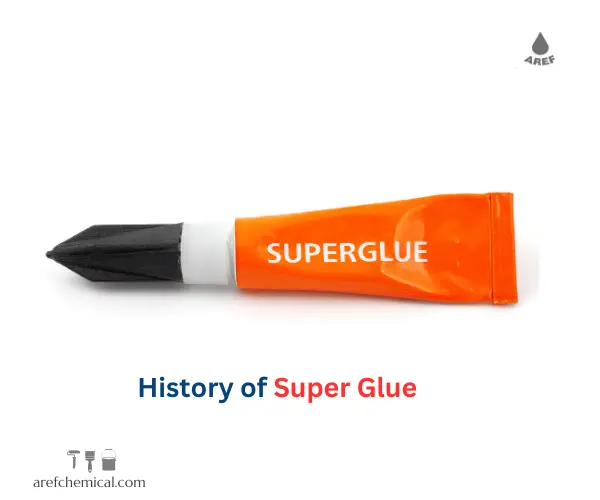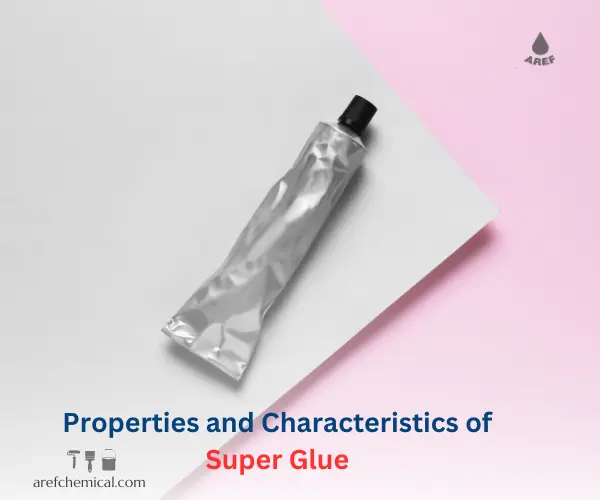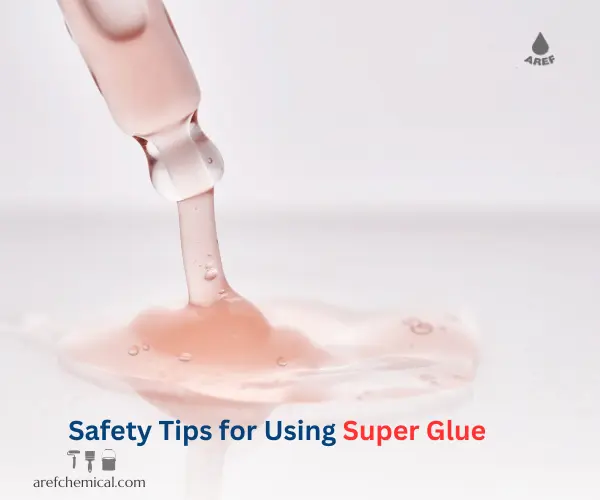Super glue, also known as cyanoacrylate, is one of the most prominent innovations in the world of adhesives, first introduced in the 1950s. This adhesive is highly regarded for its rapid and strong bonding capabilities, making it one of the most widely used and popular types of glue worldwide. Super glue can quickly bond various surfaces such as metal, plastic, wood, and ceramics, and performs well in a variety of conditions, including humid environments and low temperatures. Due to its extraordinary adhesive strength, fast drying time, and wide range of applications, super-glue has become an essential tool in households, industries, and even medicine. In this article, we will explore the history, mechanism, properties, applications, and advantages of super glue.
History of Super Glue
Super glue was first discovered in the 1940s by Harry Coover, an American chemist. Initially, this material was used as a chemical compound to produce clear lenses for military cameras. However, Coover noticed that this substance rapidly and firmly bonded any surface it came into contact with, creating a permanent connection. This characteristic lets us to use it as the best and powerful adhesive.
In 1958, super glue was introduced to the market and quickly became one of the most popular products. Today, it is produced in various forms and is widely used in many industries and daily life.
What is Super Glue?
Super-glue (or cyanoacrylate glue) is a type of fast-acting and strong adhesive commonly used to bond different materials such as plastic, wood, metals, and ceramics. Due to its unique characteristics, it has gained widespread popularity in various industries and everyday applications.
Another standout feature of the super-glue is its rapid drying time. It usually hardens within seconds and does not require long drying periods. Additionally, its exceptionally strong bonding allows it to withstand heavy weights and high pressures. Once dried, super-glue is typically colorless and transparent, making it suitable for delicate and decorative applications.
How Does Super Glue Work?
Super glue is made from a special chemical compound named cyanoacrylate. This substance is liquid in form and, when it comes into contact with moisture in the air or on surfaces, a polymerization reaction begins. During this process, cyanoacrylate molecules bond together to form a hard and durable layer. This reaction occurs very quickly, and the glue usually dries completely within seconds to minutes.
An interesting point is that super-glue is particularly effective for bonding smooth, non-porous surfaces like glass, metal, and plastic, as these surfaces provide enough moisture to initiate the reaction.
Properties and Characteristics of Super Glue
Super-glue has become one of the most widely used adhesives due to its unique properties. Its key characteristics include:
Exceptional Bonding Strength:
This adhesive can create a strong and permanent connection between various materials. It has excellent bonding power and can withstand heavy loads and pressure.
High Drying Speed:
Super-glue typically dries within seconds to minutes, making it ideal for quick and emergency applications. It starts bonding surfaces immediately after contact.
Transparency:
After drying, the glue becomes transparent, making it suitable for applications requiring a clean, trace-free appearance. Most of the time it is colorless and transparent, best for delicate projects.
Resistance to Environmental Factors:
Super-glue has good resistance to moisture, heat, and certain chemicals. While it is generally resistant to humidity and high temperatures, specialized variants with additional properties are also available.
Variety of Types:
Today, there are various types of super glue designed for specific applications. For example, some are tailored for bonding plastic, metal, glass, or even skin.
Applications of Super Glue
Due to its versatility and range of properties, super-glue is used in many fields. Some of its most important applications include:
A) Household Uses
– Minor Repairs:
Used to fix broken items such as plastic containers, household appliances, toys, and electronic devices.
– Bonding Various Surfaces:
Connecting glass, metal, plastic, and wooden components.
B) Industrial Uses
– Bonding Small Parts:
In the electronics industry, it is used to connect small and sensitive components.
– Product Manufacturing:
On production lines, it bonds various parts to create final products.
C) Medical Uses
Certain types of super-glue are used as medical adhesives to close wounds and minor surgical incisions. These glues, due to their antiseptic properties and strong bonding, are suitable alternatives to stitches.
D) Specialized Uses
– Environmental Protection:
Some types of super-glue are used to repair and preserve historical and cultural artifacts.
– Use in Handicrafts:
Ideal for connecting small pieces in artistic and handmade projects.
Advantages of Super-Glue
Super glue offers numerous benefits, including:
– Speed:
Thanks to its quick-drying nature, it’s perfect for swift and emergency situations.
– Ease of Use:
It can be applied without complex tools and is easy to use.
– Durability:
The bonds created by this adhesive are typically permanent and resilient.
– Transparency:
After drying, it becomes clear, making it suitable for delicate applications.
Disadvantages and Limitations
Despite its many advantages, using super glue comes with some challenges:
– Sensitivity to Contaminated Surfaces:
To achieve the best results, ensure the surface is clean and dry.
– Limited Application Time:
Due to its rapid drying, there is little time to adjust the pieces.
– Lack of Flexibility:
The bonds created are often brittle and may break under pressure or impact.
– Sensitivity to Chemicals:
Some types of super glue may have lower resistance to certain chemicals.
Safety Tips for Using Super Glue
Despite its many advantages, using super glue requires caution. Its fumes can be harmful, so it is recommended to use it in a well-ventilated area. If the glue comes into contact with the skin, it should be washed with warm water and soap, and medical attention should be sought if irritation or issues arise. Be sure to follow these tips:
-Avoid Skin Contact:
Super glue can quickly bond skin. If contact occurs, wash with warm water and soap.
– Proper Storage:
Store in a dry, secure place out of children’s reach.
– Proper Ventilation:
Ensure you are in a well-ventilated area while using it.
Future Prospects of Super Glue
Thanks to its bonding strength and speed, super glue is an essential tool in every home and workshop. With technological advancements, super glue is rapidly evolving. New types of super-glue with enhanced environmental resistance and even flexibility are being developed. Additionally, its use is expanding into new fields such as medicine, aerospace, and environmental protection.
Conclusion
Super glue, with its unique properties such as strong bonding, rapid drying, and wide-ranging applications, is one of the most important modern tools in daily life and various industries. Despite its limitations, it remains highly valued in the market due to its ease of use and durability. With technological advancements, it is expected that super-glue will play an even greater role in improving quality of life and advancing various industries.







27 Responses
This adhesive contains pressure-sensitive resins that, when two surfaces are bonded together, create a strong, durable bond within seconds or minutes.
Super glue, also commonly called electric glue or instant glue,
This adhesive contains pressure-sensitive resins that, when two surfaces are bonded together, create a strong, durable bond within seconds or minutes.
Super glue (cyanoacrylate adhesive) is widely used in various applications due to its fast bonding and strong adhesion.
Home repairs: fixing broken ceramics, plastic, or small furniture parts.
Crafts and DIY projects: bonding small decorative items, models, or jewelry.
Super Glue is a fast-acting adhesive known for its strong bonding capabilities.
Its chemical name is cyanoacrylate, and it bonds quickly to a variety of surfaces such as metal, plastic, rubber, and ceramics.
It’s commonly used for quick repairs around the house, in crafts, and industrial applications. It’s important to use it carefully, as it bonds skin instantly and can be difficult to remove.
Super Glue, or cyanoacrylate adhesive, was first developed in the 1940s and became popular for its remarkable strength and quick bonding time.
High strength can withstand considerable stress and tension.
It was discovered in 1942 accidentally by Dr. Harry Coover and his team at Eastman Kodak during research focused on clear plastic guns for WWII. Initially, it was too sticky for those purposes.
In 1951, Coover and colleagues realized its potential as an adhesive, perfect for bonding materials rapidly.
Eastman Kodak licensed the product in 1958, and it was introduced as “Super Glue” in the United States in 1970, becoming instantly popular for its quick-bonding properties.
Since then, formulations have improved to reduce skin bonding hazards and enhance strength and versatility.
Super Glue revolutionized bonding techniques with its fast, strong adhesion, and remains a household staple today.
Super glue, or cyanoacrylate adhesive, works through rapid polymerization. When it comes into contact with moisture (even tiny amounts like skin oils), the cyanoacrylate molecules quickly bond with water molecules, initiating a chain reaction. This reaction causes the adhesive to harden almost instantly, forming a very strong bond between surfaces.
The glue molecules stick to the surface.
Super glue create a strong and permanent connection
Super glue hardens within seconds
The glue is transparent after being transparent
This perfect glue has good resistance to moisture
🙏🏽🙏🏽🙏🏽🙏🏽🙏🏽
👌🏻👌🏻👌🏻👌🏻👌🏻
😍😍😍😍😍
Super glue is wonderful
https://tavatranslation.com/
🙏🙏🙏🙏🙏🙏